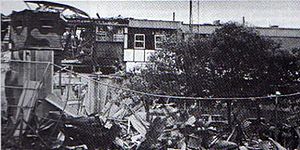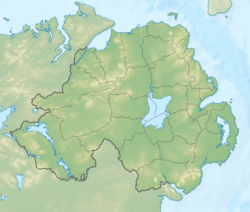Glenanne barracks bombing facts for kids
Quick facts for kids Glenanne barracks bombing |
|
|---|---|
| Part of the Troubles | |

Part of the UDR barracks after the attack
|
|
| Location | Near Mountnorris, County Armagh, Northern Ireland |
| Coordinates | 54°14′14.54″N 6°30′17.42″W / 54.2373722°N 6.5048389°W |
| Date | 31 May 1991 23:30 (UTC) |
|
Attack type
|
Bombing, gunfire |
| Weapons | Truck bomb |
| Deaths | 3 soldiers |
|
Non-fatal injuries
|
10 soldiers 4 civilians |
| Perpetrator | Provisional IRA |
The Glenanne barracks bombing was a major attack by the Provisional IRA on a British Army base. This base, used by the Ulster Defence Regiment (UDR), was located at Glenanne, near Mountnorris, County Armagh, in Northern Ireland.
On 31 May 1991, a large bomb hidden in a truck was rolled down a hill. It crashed into the back of the barracks. The explosion killed three soldiers and injured 14 people, including four civilians.
Contents
What Happened Before
Peace Talks and the Barracks
This bombing happened when leaders were trying to hold peace talks about the future of Northern Ireland. These talks were called the Brooke/Mayhew talks. Members of Sinn Féin, a political party, were not invited. This was because of their links to the IRA, which was a group that used violence. The talks did not succeed soon after the bombing.
The Glenanne barracks was built in 1972. It was home to two companies of the Ulster Defence Regiment (UDR). The UDR was a part of the British Army. The barracks was seen as an important military spot. It was located between an area where most people were Protestant and an area where most people were Catholic.
Even though the barracks itself had not been attacked before, seven UDR soldiers from this base had already died during The Troubles. "The Troubles" was a period of conflict in Northern Ireland.
The Bombing Event
The Attack Plan
At 11:30 PM, a truck carrying about 2,500 pounds (1,134 kg) of a new type of homemade explosive was used in the attack. The truck had no driver. It was rolled down a hill behind the barracks. It then crashed through the fence around the base.
A UDR soldier saw the truck. He also saw a van with at least two masked and armed men nearby. He thought the IRA was about to launch a mortar attack. He quickly warned the base. Some people inside the base also thought the noise from the truck hitting the roof was a mortar. Other witnesses heard gunshots just before the main explosion. Some reports say IRA members fired at the truck to set off the bomb. The truck had been stolen the day before in the Republic of Ireland.
The Huge Blast
The explosion created a crater 200 feet (61 meters) deep. It threw pieces of debris and metal up to 300 yards (274 meters) away. The sound of the blast was so loud it could be heard more than 30 miles (48 km) away, as far as Dundalk. This was the biggest bomb the IRA had ever used up to that time.
Most of the UDR base was destroyed by the explosion and the fire that followed. Nearby homes had broken windows and falling ceilings. A local primary school was also damaged. Cars parked outside the base were completely destroyed.
Casualties and Aftermath
Usually, about eight soldiers were at the barracks. But at the time of the bombing, there were 40 people inside. They were attending a social event. Three UDR soldiers were killed: Lance Corporal Robert Crozier (46), Private Sydney Hamilton (44), and Private Paul Blakely (30). Ten other soldiers were injured. Two of the soldiers who died were caught by the explosion when they went outside to check after the alarm was raised. The third soldier died inside the base. Four civilians were also injured. The Provisional IRA said they were responsible for the attack two days later.
The Glenanne UDR barracks was never rebuilt. A decision had already been made to close it down because it was no longer as useful. Not rebuilding the base caused some debate among unionists. A memorial stone was later put up at the main entrance road. It lists the names of the UDR soldiers who died while serving at Glenanne over the years.


